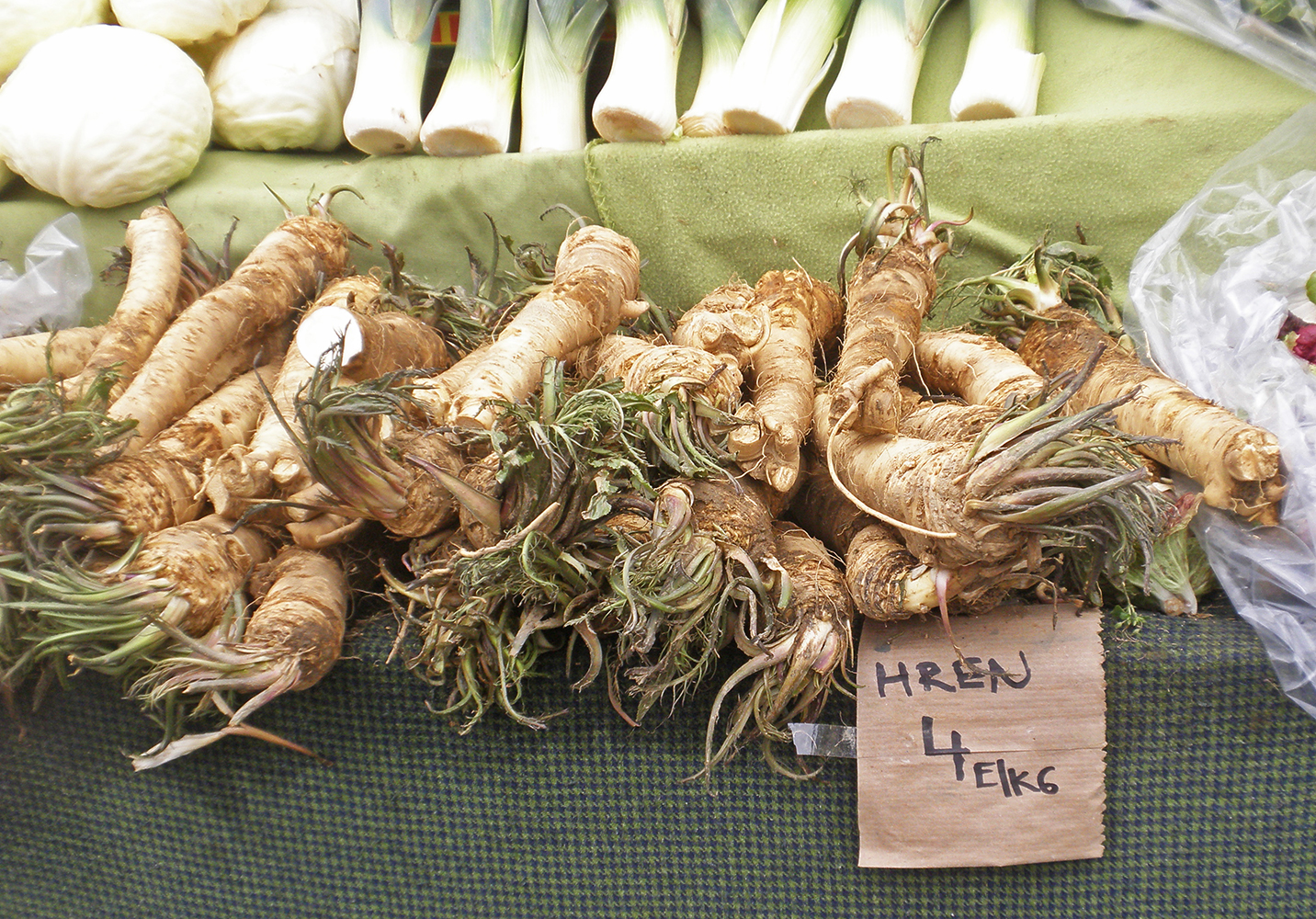Horseradish in Collinsville
Horseradish (Armoracia rusticana) is a European perennial root vegetable commonly used as a condiment. In Illinois, this specialty crop is mainly grown in the American Bottom with St. Clair, Monroe, and Madison Counties having the most concentrated commercial growth of horseradish in North America.((Some sources claim it is the most concentrated growth in the world and others say in the United States.)) There are many horseradish farms and production facilities in Madison County, especially in and around the city of Collinsville.((In the world of horseradish 10-15 farms is considered many. There were 10 farms in Madison County in the 2012 USDA Census. Tom Vilsack, Secretary, 2012 Census of Agriculture: Illinois State and County Data, Volume 1: Geographic Area Series: Part 13 (Washington D.C.: U.S. Department of Agriculture, 2012), 531.)) Due to this, Collinsville is the self-proclaimed “Horseradish Capital of the World.”((Jenna Smith, “Illinois Horseradish Has Quite the Kick,” The Pantagraph, July 10, 2013.))
The horseradish plant (Armoracia rusticana) has large, leathery leaves and small, four-petaled flowers.
From Wikimedia Commons
The American Bottom, also called the American Bottoms, is a Mississippi River floodplain in southern Illinois which extends from Alton south to the Kaskaskia River. This area is ideal for growing horseradish because the soil is sandy, loose, and rich with nutrients, such as potash, from centuries of flooding.((Sarah Baraba, “Deep Roots: Collinsville’s Long-Lasting Claim to Horseradish Capital,” St. Louis Post Dispatch, May 24, 2012, (accessed October 9, 2017).)) Horseradish grown in and around the Collinsville area is highly desirable because the potassium-rich potash gives horseradish extra heat.((Ibid.))
Horseradish is a European root vegetable that belongs to the genus Brassica of the mustard family (Brassicaceae), which includes cabbage, broccoli, radish, cauliflower, turnips, and kale.(( David Robson, “David Robson: Herb of the Year – Horseradish,” The State Journal – Register, January 29, 2011.)) It is a perennial crop, which means it comes back year after year.((Sharon Arnot, “Collinsville is The Horseradish Capital of the World,” Sauce Magazine, January 30, 2003, (accessed October 10, 2017).)) The flowers of the plant have four petals and resemble a cross.((Robson, Horseradish.)) The leaves of the horseradish plant are thick, leathery, can be quite large, and grow bunched together, much like dandelions.((Ibid.)) The leaves are dark green, crinkled, and prevent most insects and animals from eating the crop.((Ibid.)) Although the leaves of the plants are edible, it is the root that people prefer to eat. The hardy, white root is covered in a thick brown bark and usually grows eight to twelve inches in length and about an inch wide before it is harvested.((Ibid.))
Horseradish roots for sale in Ljubljana, Slovenia
From Wikimedia Commons
Farmers plant horseradish in the early spring and harvest it in the late fall after the first frost.((Ibid.)) It needs long summers for growing and cold winters for dormancy.((Collinsville Chamber of Commerce, “International Horseradish Festival- Celebrating 30th Anniversary,” International Horseradish Festival (accessed October 20, 2017).)) It is a labor-intensive crop as there are no modern machines built specifically for planting and harvesting it. Some farmers have modified potato harvesters to help with the labor, but most of the planting and harvesting is still done by hand.
After the root is harvested, it is cleaned and graded for size and quality.((Stuart Englert, “Horseradish Capital of the World,” American Profile, May 10, 2011 (accessed October 9, 2017).)) The roots are crated and stored in freezers until they are sold and shipped to produce companies and food processors around the world.((Ibid.)) The processors will grate the root which releases the pungent smell and taste.((Collinsville Chamber of Commerce, International Horseradish Festival.)) They mix the grated root with vinegar to stabilize it, so it is not as hot in flavor, and also to preserve it, so it will not turn brown and bitter.((Smith, “Illinois Horseradish Has Quite the Kick.”)) Different procedures add salt, sugar, cream, or vegetable oil, but usually the prepared horseradish on the market only contains the grated root mixed with vinegar.((Collinsville Chamber of Commerce, International Horseradish Festival.))
Commercial horseradish farming began in the fertile American Bottom around the 1850s by immigrant German farmers.((Horseradish Information Council, “Horseradish History,” Horseradish.org (accessed October 9, 2017).)) It is believed that the first two families to farm horseradish in the Collinsville area were the Fingerhut and Bruns families, both of which were German.((Nicole Dinkelmann, “Horseradish in Southern Illinois,” Illinois Periodicals Online, (accessed October 8, 2017).)) By the late 1890s, the horseradish industry was thriving in the Collinsville area.((Horseradish Information Council, “Horseradish History.”)) Many farmers passed down their land and knowledge to their children, so many modern farmers in the region are at least third-generation farmers.((Englert, “Horseradish Capital of the World.”))
As the self-proclaimed “Horseradish Capital of the World,” Collinsville has hosted the International Horseradish Festival every year since 1988.((Collinsville Chamber of Commerce, International Horseradish Festival.)) The festival offers horseradish root games and contests, such as Root Toss, Root Golf, and Root Sacking.((Ibid.)) Both the roots and processed horseradish are sold at the festival. Notably, special batches of horseradish are produced about a week before the festival and sold without preservatives added. This offers a unique chance to buy the freshest and hottest horseradish possible.((Baraba, “Deep Roots: Collinsville’s Long-Lasting Claim to Horseradish Capital.”)) Multiple demonstrations are held throughout the duration of the festival to show how to grind the root and add the correct amount of vinegar to get the desired heat.((Collinsville Chamber of Commerce, International Horseradish Festival.)) The International Horseradish Festival also offers live music, other food, many events, and crafts.


